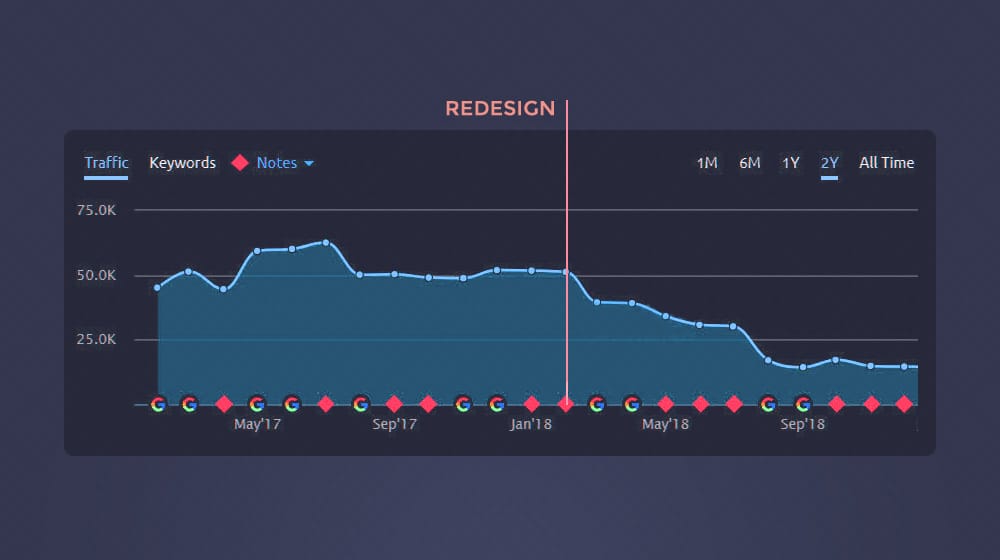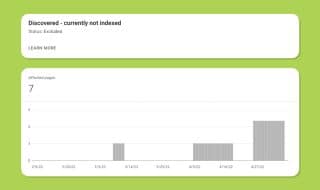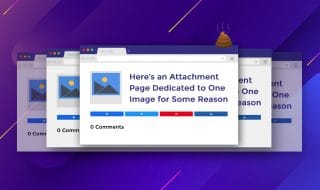Why Did My Traffic Drop After a Redesign? (And How to Fix It)

Redesigning a website is a difficult task. You need to make a new, better design and ensure it works on various devices and meets modern design, UX, and SEO sensibilities. On top of that, you need to implement your redesign in a way that doesn't ruin your traffic.
All too often, site owners implement redesigns without paying attention to the SEO impact it will have. Then they wonder why they had a massive traffic loss and are struggling to recover.
On the plus side, there's good news.
- Google is generally smart enough to recognize that your site is the same and restore most of your rankings. This process might take a while, as you'll have to wait for their crawler to stop by a few more times until the dust settles.
- If you know what you're doing, to can implement some fixes to bring it back faster.
Of course, a lot depends on the changes you made to your site design and if they negatively impact SEO. If you make everything dynamically generate with scripts and hide it within an iframe, there's not much you can do, but at least that kind of redesign is rare.
Let's say you've done a redesign on your site, and now you're seeing a steep drop in traffic. What can you check to fix it and get that traffic back?
Understand the Google Sandbox (and Wait it Out)
First, one thing to recognize is that Google is cautious regarding websites that change dramatically and suddenly. In the past, this kind of change has indicated some exploit, whether a site being sold and redesigned, a website being hacked and compromised, or just a webmaster getting sick of it and turning their site into something malicious.
So, when a site undergoes a significant change, Google will temporarily shuffle it around to figure out what's happening with the new structure. Most of the time, this is temporary, especially once they notice that the majority of the value of your site is still there; it just may have moved.

So, in some cases, you may be able to wait out your traffic drop. It might take a few weeks or months, but it probably won't take longer than that. Unless it does, you have other problems to fix first.
I don't recommend this option, of course. It's always better to be proactive and fix potential problems before they solidify.
I bring up the Google sandbox for one main reason: so you know that everyone will experience a traffic drop when they push a redesign, even when that redesign is executed flawlessly. But, if it takes more than a few days or weeks to recover, you likely have more significant issues to check into.
I recommend a handful of SEO tools for analyzing your site and having multiple devices to test it on. Check out Ahrefs site audits, Moz Open Site Explorer, Screaming Frog for scraping internal link data and looking for errors, and tools like this for analyzing redirects. You can get valuable data from software like this and identify mistakes you didn't know you missed but can fix relatively quickly.
Examine Changes in Your Site Architecture
One key to understanding how Google works is to know that every single page is a unique page as identified by its URL.
Sounds simple, right?
Pop quiz: what happens if you change the URL?
To you, it might be a minor change. To Google, it changes every blog post URL to a new URL. As far as Google is concerned, your old blog is gone, and your new blog is entirely new, so they have to reindex and re-rank it. All of the old pages will show up as 404 "Not Found" without proper redirects.
So, if you change your URLs, you must be highly rigorous with your redirects. I have a guide about moving a blog from one URL to another, which covers redirects in detail, but I'll give you a summary here.

You need to know how to implement 301 redirects - 301 redirects are the "moved permanently" redirect, and tell Google that the old URLs are not going to return and that the content at those old URLs is now found at new URLs.
Is this a lot of work? Sure. You need to 1:1 map every URL from your old site to your new site for any page that changed. Otherwise, you lose the SEO value of the old posts, you lose any backlinks pointed at them, and it will take longer for Google to fully index and rank the new pages.

There are a few common mistakes people make with redirects. Check to make sure you aren't making any of these:
- Not using 301s. There are other redirect forms, but 301s are the best for maintaining SEO value.
- Not creating a 1:1 map. It's a lot easier to take all of your old pages and redirect them to your homepage, but that will nuke your SEO value entirely, including basically making your old backlinks meaningless.
- Canceling your old domain. If you changed from one domain name to another, you still need to maintain the old domain so it can host the redirects. If you moved domains, you'd want to keep the old domain active forever to keep those redirects in place. Any data on it, including your redirects, will also disappear if you cancel or let it expire.
- Only redirecting some pages. Sure, many older pages might not have organic traffic, but if they had links, it was still a good idea to implement the redirect.
You might consider creating a list of all of your backlinks, identifying the ones pointing to pages that changed, and sending out an email to the site owners who linked to you and asking them to change their links to the new pages. You can "recover" a decent number of backlinks this way, though it won't eliminate the need to implement redirects unless you get a 100% conversion, which won't happen.
One final detail that's often overlooked: your sitemap!

When you change your URLs somehow, you need to generate a new sitemap and resubmit the updated version to Google. If the sitemap Google is using still points to old, now-removed URLs, you will have a hard time. Luckily, this is super easy to fix.
Your New Design is Worse for Speed and Web Vitals
Google's algorithm has, over the last decade, pushed more and more for "function over form" in websites. That is, they care a lot about certain kinds of functionality and don't care as much about what your site looks like beyond that.
What do I mean? It's all about how usable your site is. Things like:
- Site speed.
- Page loading times.
- First and largest content paints.
- Layout shift.
- Reliance on scripts.
They don't care if your logo is in the left or middle corner. They don't care if your navigation bar floats with the user, sticks to the top, or lives in a sidebar. They don't care if you use bright colors or grayscale. They care about a fast-loading, responsive, mostly-static-feeling site.

Unfortunately, the people in charge of website redesigns are often more excited about cool dynamic features, bold, up-front media, and other things that make site speed tank, don't work on mobile, or cause other problems. It's easy to lose sight of the fact that, no matter how cool your site looks, your rankings and search traffic will suffer if your current website isn't indexable or doesn't load quickly on slow mobile devices. Most web designers are not digital marketing experts.
My recommendation? Perform a thorough audit using tools like PageSpeed Insights and the Core Web Vitals report and evaluate the various data points you're given in Google Search Console. Google is pretty straight with web admins; they'll just tell you what's wrong if they find a problem. All you need to do is fix it.

Remember, too, that Google uses mobile-first indexing. That means if you have a mobile version of your website (and a responsive website design counts), Google will use the mobile version preferentially to the desktop version to index your page.
Another common issue is that your fancy new features get in the way of a good user experience. It doesn't matter if you have a fancy new homepage if that homepage now gets in the way of a user trying to find their way to a subpage they want to see. Sometimes, simple "design streamlining" can remove things Google likes you to have, like breadcrumbs. Remember that your user experience is critical, even if it's hard to define.
Your Old Website Still Exists
So, above, I mentioned that if you change domain names, you must keep the old domain around to maintain redirects properly.
One mistake I see is keeping the entire old site around. This practice can hurt your SEO for a straightforward reason: duplicate content.
Sometimes, the connection is clear enough, and Google won't penalize you for it. They can recognize that changing your domain name to better align with your brand name means it's still you, and if you have redirects in place, the old version wouldn't be visible to anyone who didn't block them somehow.

You can't rely on sensible judgment. If a human were to review the two websites, you wouldn't have a problem, but robots decide 99% of Google's algorithm, and humans occasionally spot-check the results. Other times, the change is significant enough that the connection isn't apparent. Then, if you add in other problems like improper redirects, you end up with many search engine optimization issues.
You Have Script Errors
On a more technical level, script errors can cause many problems. Even if a broken script is invisible to users, it can cause issues with Google. Alternatively, maybe your scripts work locally but don't work once the site is live, or they work for specific browsers but not others - or they work for desktop but not mobile. Script errors can be wily like that!

One of the most significant script errors that can cause problems is errors with the Google Analytics script. When you change your site design, you might end up with a broken GA tag, duplicate GA tags in your header, or a disconnect between your GA account and the new website property you're tracking.
These can result in broken analysis and reporting. I've seen this a dozen times, where a site owner thinks their website traffic has disappeared, but their Google Analytics is just broken for most of their important pages. It's an easy fix, but you can't recover your missed data.
In any case, performing a thorough audit of the scripts you use on your site can be another way to diagnose and fix issues preventing adequate indexation and search rankings.
Did you recently perform a site redesign and end up losing search traffic? Drop me a line, and I can look to see if there's anything obvious you can fix to get it back.










August 15, 2022
I was so proud of our redesign so I was so confused when our traffic started dropping. We'll try to take a closer look and see if it's the overall speed.
August 22, 2022
Hey Richard,
More important than speed is checking your redirects and Google Search Console! I would start there and work your way down this list 🙂 Good luck!
March 18, 2023
I have recently transformed my blog into a website and noticed a decline in traffic. This change was implemented just yesterday. I have already requested indexing and submitted a new sitemap. Are there any additional suggestions you could provide? Thank you.
March 20, 2023
Hi Donna! Congrats on the new website design.
The most common reason for a drop in traffic after a new design is broken pages and/or missing redirects.
I recommend loading an old version of your website or finding a complete list of every page that Google had indexed on your old site and then visiting them each, one by one.
If any of them show a 404 page or are otherwise broken and not redirecting, you've found your issue.
This is a safe thing to do right away. If Google is coming by your site and they see a bunch of your old pages are no longer there, they will probably pull back on your rankings, so visitors aren't annoyed with "404 Error" messages. That doesn't make you look bad - it makes search engines look bad for serving that broken page. So they want to temporarily reduce your rankings until you have it figured out.
Monitor your search console every day and be on the lookout for errors, indexing issues, broken pages, canonicalization issues, and so on.
To be honest with you, it's probably too early for you to tell since you just launched the new website yesterday. I still recommend triple-checking that your redirects are set up and that you haven't accidentally deleted or changed the URLs on your old site without implementing redirects. But after verifying all of that, I would give it a few weeks before drawing any conclusions 🙂